Brief

Executive Summary
- In the first quarter of 2020, we predict that global luxury sales will suffer a year-over-year decline of 25% to 30%, although there are signs of recovery in China.
- For the year as a whole, we modeled three scenarios for the likely performance of the market, involving contractions of 15% to 18%, 22% to 25%, and 30% to 35%.
- Leadership teams can mitigate today’s threat and accelerate into an eventual recovery if they govern through a new leadership framework; maximize short-term financial, operational and brand resilience; and transform the value proposition and business model for the future.
From the earliest stages of the pandemic, the luxury industry has been highly attuned to the spread of the coronavirus—and its massive implications for the sector. Luxury brand owners felt the first rumblings of the storm when Covid-19 spread through China, the country whose citizens accounted for 90% of global luxury market growth in 2019. When the virus reached Italy, where many brands are headquartered and have key suppliers, they faced the additional challenge of operating as and where possible amid a national lockdown.
With key luxury markets around the world now affected, brands are doing everything they can to protect the well-being of their employees and customers, through store closures and other measures. They are also assisting the frontline public health response where possible (for instance, by offering to use their factories for the production of essential goods such as hand sanitizer or protective clothing).
Beyond the public health crisis, the pandemic poses a serious threat to the sector. Gross domestic product, employment (and therefore spending power) and financial markets are under severe strain, with a consequent plunge in consumer confidence and willingness to spend. In addition, purchases of luxury goods and services by tourists will continue to be disrupted by travel restrictions and a lingering fear of possible contagion on planes and cruise ships.
With the pandemic still developing, it is difficult to predict accurately its full impact on the broader economy and the luxury industry specifically; its evolution and duration will depend on the response of individual governments and populations. However, we can at least start to assess the immediate economic impact of the crisis.

Macro Surveillance Platform
For more detail on the business implications of coronavirus from Bain’s Macro Trends Group, log on to the Macro Surveillance Platform. Learn more about the platform >
As of March 25, we forecast that the luxury market globally will contract by 25% to 30% year-over-year in the first quarter. For 2020 as a whole, we’ve modeled three scenarios, with the intermediate scenario suggesting a contraction of between 22% and 25% (amounting to a decline of approximately €60 billion to €70 billion). Profitability will be disproportionately hit. Yet there is an emerging bright spot: The Chinese market already appears to be on its way to recovery.
As luxury leadership teams plan their next moves, prioritizing action in three areas will help companies mitigate the worst of today’s turbulence and accelerate into an eventual recovery. Those three pillars are “Govern through a new leadership framework,” “Act to maximize short-term financial, operational and brand resilience” and “Transform the value proposition and business model for the future.” In spite of the short- and medium-term impact, luxury brands can emerge from the crisis stronger, more innovative and more purposeful.
Tallying the cost of the early stages of the outbreak
Our forecast of a 25% to 30% market contraction in the first quarter of 2020 is based on information available on March 25, such as data on the spread of Covid-19, macroeconomic data, the trading of leading industry players and expert interviews conducted by Bain & Company. Given the rapid evolution of the situation—and the likely pace of future developments—there is a high degree of uncertainty about the forecast and our related modeling for 2020.
That said, there’s no doubt that luxury is highly exposed to Covid-19. Chinese consumers represent 35% of the global personal luxury goods market. And that’s to say nothing of the travel restrictions that are choking off tourism and travel retail, or the deteriorating economic outlook and its probable impact on spending power. With all these factors and more at play, the next few weeks are going to be critical for the sector.
The luxury brand executives we interviewed indicated that, after an exceptionally positive start in January, the performance of the global market in the early part of 2020 has closely mirrored the spread of the virus (see Figure 1). Asia suffered a significant sales decline, with China at the forefront of the negative trend. Almost every luxury brand in China had to temporarily close stores or reduce working hours, creating deep double-digit year-over-year sales declines; however, at luxury stores that have since reopened, consumers are returning faster than expected. The virus has had a double impact on luxury consumption in other Asian countries such as Japan and South Korea, discouraging free-spending Chinese tourists from visiting and harming local consumer confidence.
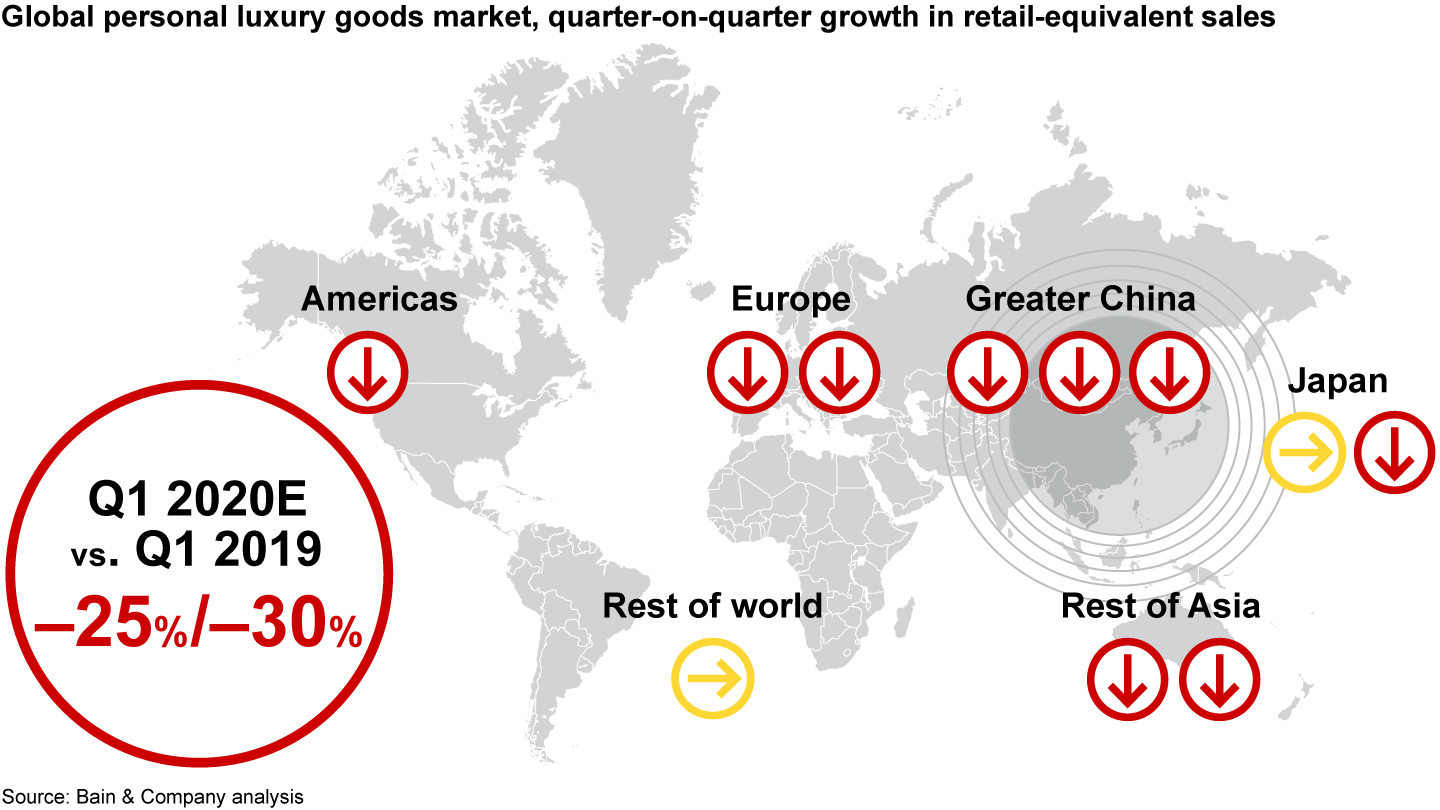
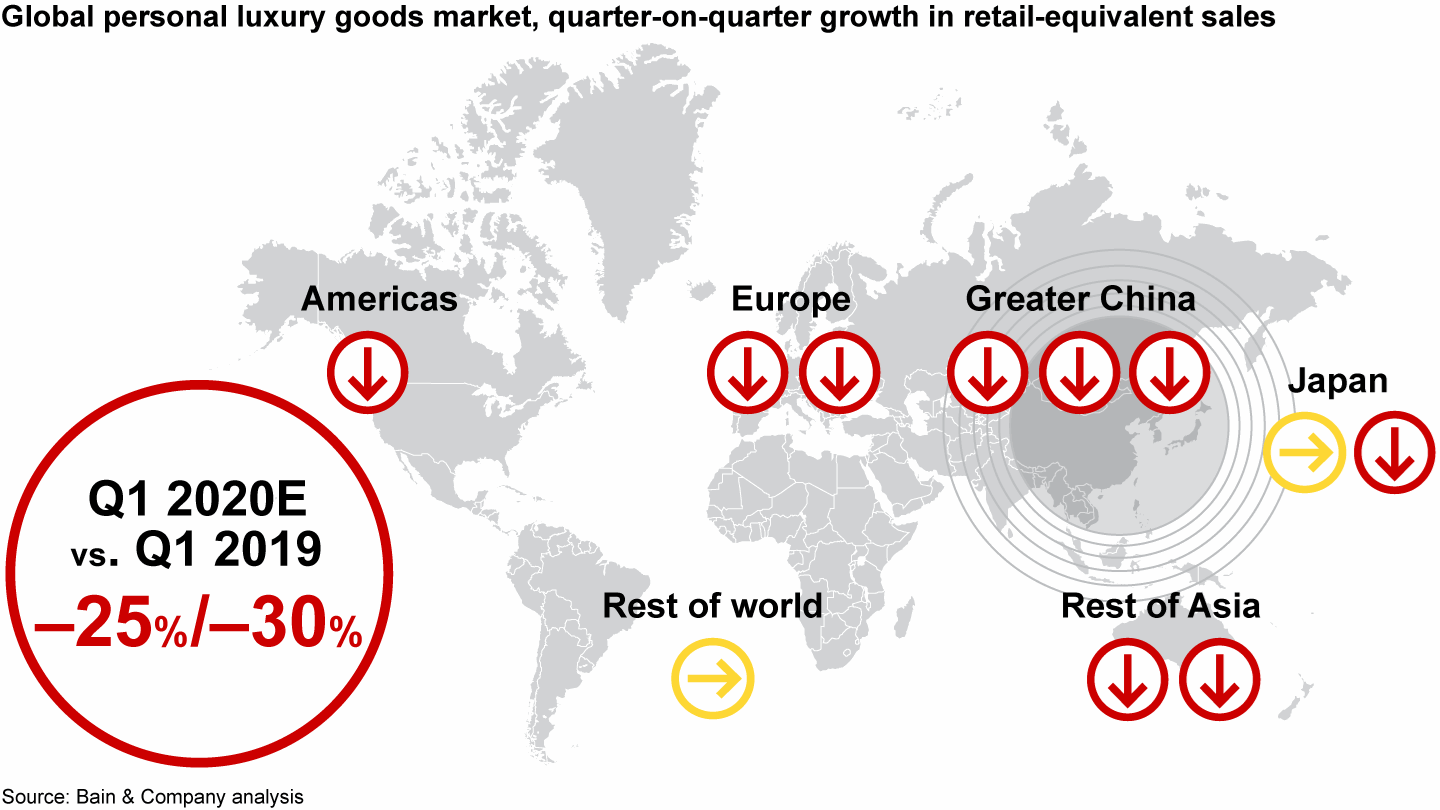
The luxury market in Europe had been stable in the first two-and-a-half months of the year, although with substantial variation between countries. The Italian market suffered worst, as quarantines caused double-digit sales declines across the country. Sales rose overall in France, Spain, Germany and the UK, thanks to tourism (especially from Russia and the Middle East) and stable local demand during the early stages of the outbreak. Unsurprisingly, consumer confidence had begun to weaken in those territories even before governments put restrictions in place to stop the virus’s advance across the continent. At the time of writing, the trend has quickly turned deeply negative, with general store closures in multiple countries.
The luxury market in the Americas is also starting to feel the full impact of coronavirus disruption. A decline in (predominantly Chinese) tourist spending did not appear to have had much of an impact in the first two-and-a-half months of the year. But the positive trend we saw for the majority of the quarter is already coming under intense pressure as most players shut their American stores.
The trend was negative in the airport channel, as the drop in air traffic from Asia was only partly balanced by continued tourism within Europe and the Americas. Off-price sales of luxury goods grew, partly because full-price sales are still dominant in hard-hit Asian economies. Online sales experienced double-digit growth in Europe and the Americas, and only a limited slowdown in Asia.
Three scenarios for 2020—and six consumption trends
Consumption of luxury goods has weathered past crises. The impact of the 2002–03 SARS outbreak was softened by the fact that the industry was not as dependent on China as it is now. After the 2008–09 global financial crisis, increasingly wealthy Chinese consumers kept spending when western demand flagged.
However, there are key differences this time around. Chinese consumers are more affected by Covid-19 than they were by the credit crunch; they are unlikely to ride to the rescue in quite the same way—and there is no other emerging cohort of luxury customers to tap. The coronavirus “fear factor” is greater than past crises too, weakening financial markets. Its impact on the real economy—job losses, GDP declines and so on—is set to be extensive. Finally, luxury shopping by travelers will take longer to recover, as countries maintain restrictions on travel to prevent further waves of outbreak and some people remain nervous about flying or cruising.
Based on the information available so far, we have modeled three scenarios for the likely performance of the global luxury market in 2020. The different potential outcomes reflect a range of assumptions for the duration, geographic depth and intensity of the outbreak; other variables include expectations for GDP, consumer confidence and other macroeconomic indicators. The scenarios factor in immediate lost sales as well as the delayed impact of lower wholesale orders.
The first scenario assumes a mounting recovery in demand in the second half of the year, limiting the overall market contraction to 15% to 18% for 2020 as a whole (see Figure 2). In the second scenario, the market would decline by between 22% and 25%, remaining in negative territory through the fourth quarter. In the third scenario, the market decline would be between 30% and 35% due to a more prolonged period of depressed sales. In all three scenarios, profit would suffer a steeper decline than sales.
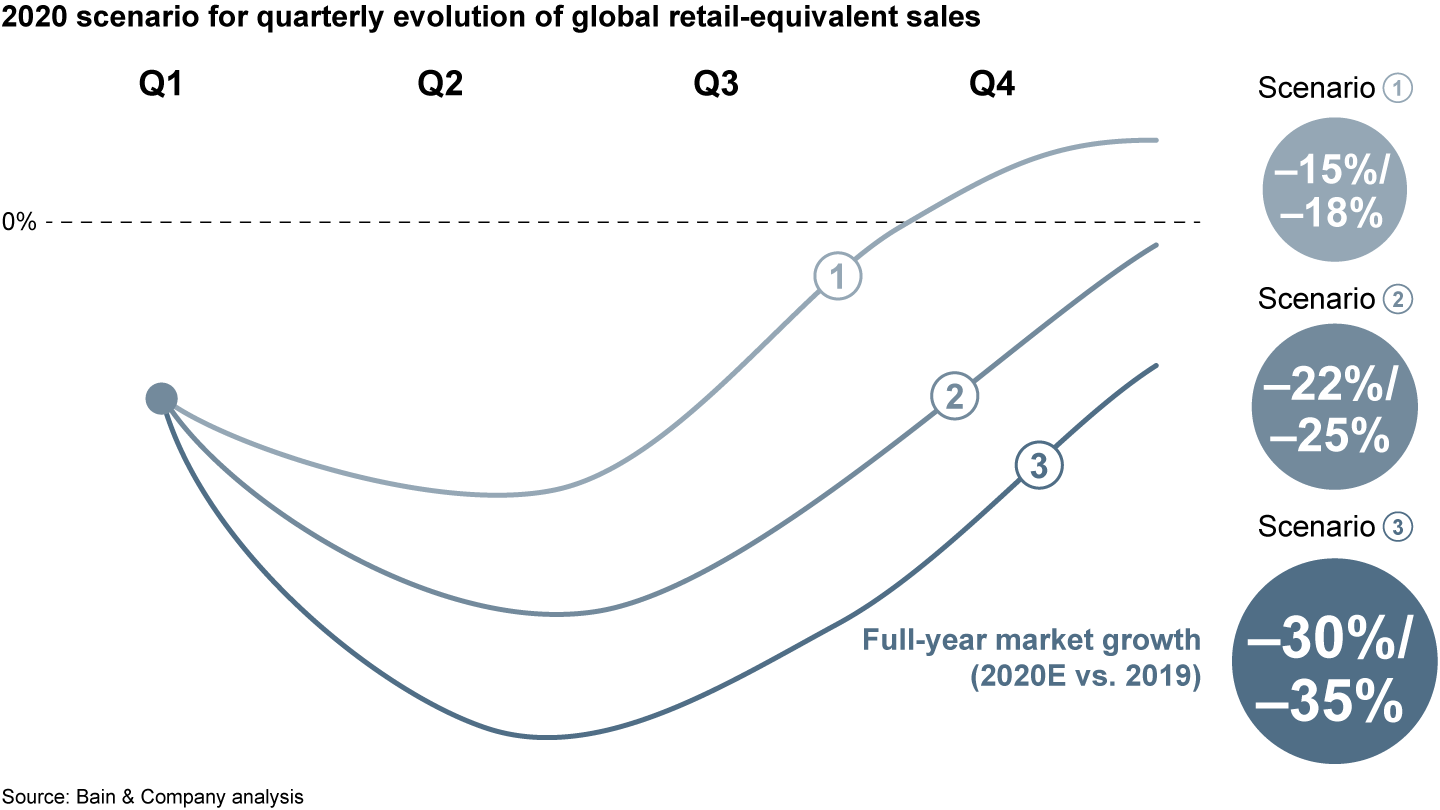
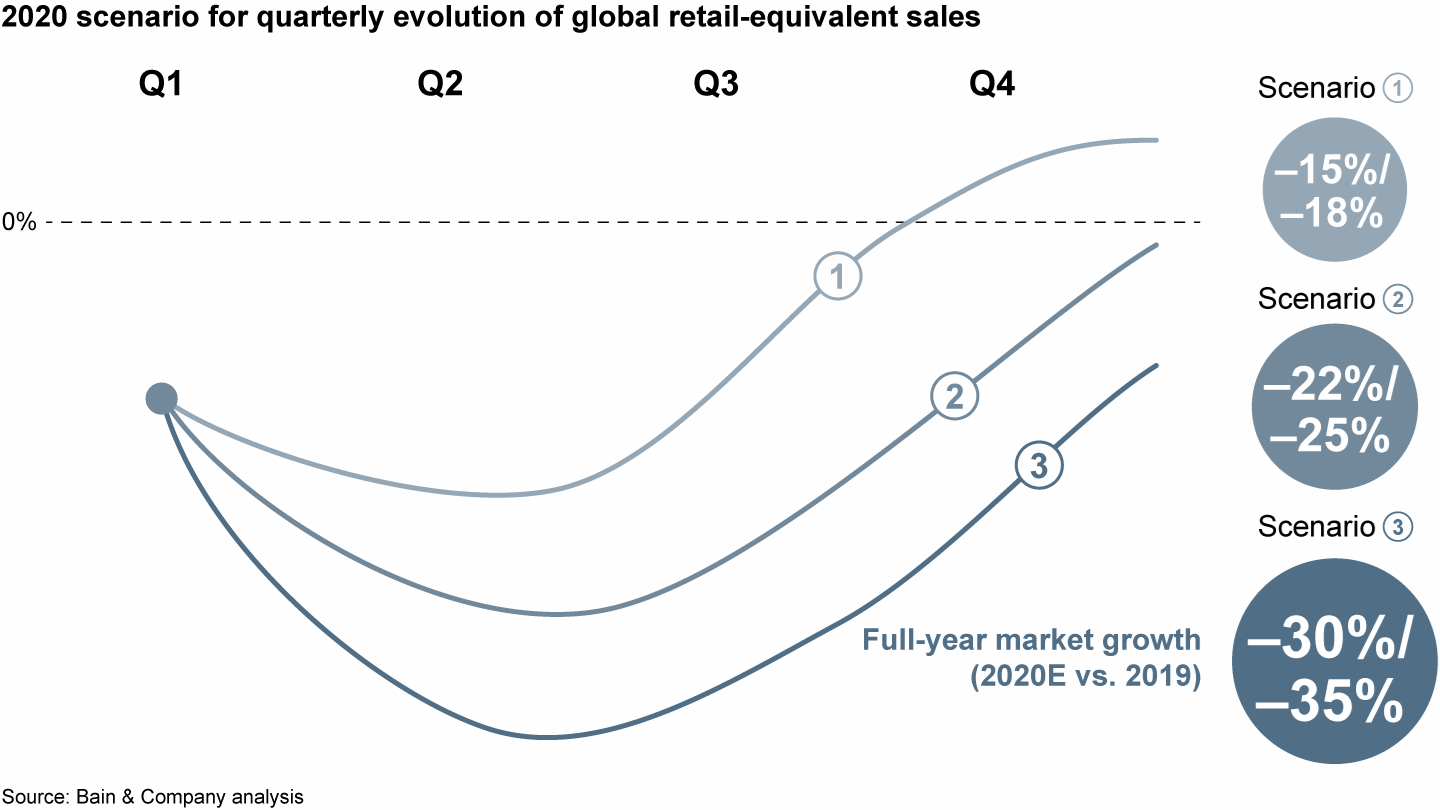
We expect that the pandemic will continue to reverberate through the industry in 2021. Some countries will likely experience a rapid rebound while others will see more of a “dip and stabilization” (see Figure 3). China and the broader Asian market could experience the strongest recovery; Japan, Europe and the Americas could feel a more prolonged impact, depending on how the real economy fares. Nevertheless, we think that medium-term market growth will be supported by demand from the Chinese middle class, an increased appetite for luxury goods among millennials and their younger counterparts in Generation Z, and the digital channel’s continued maturation.
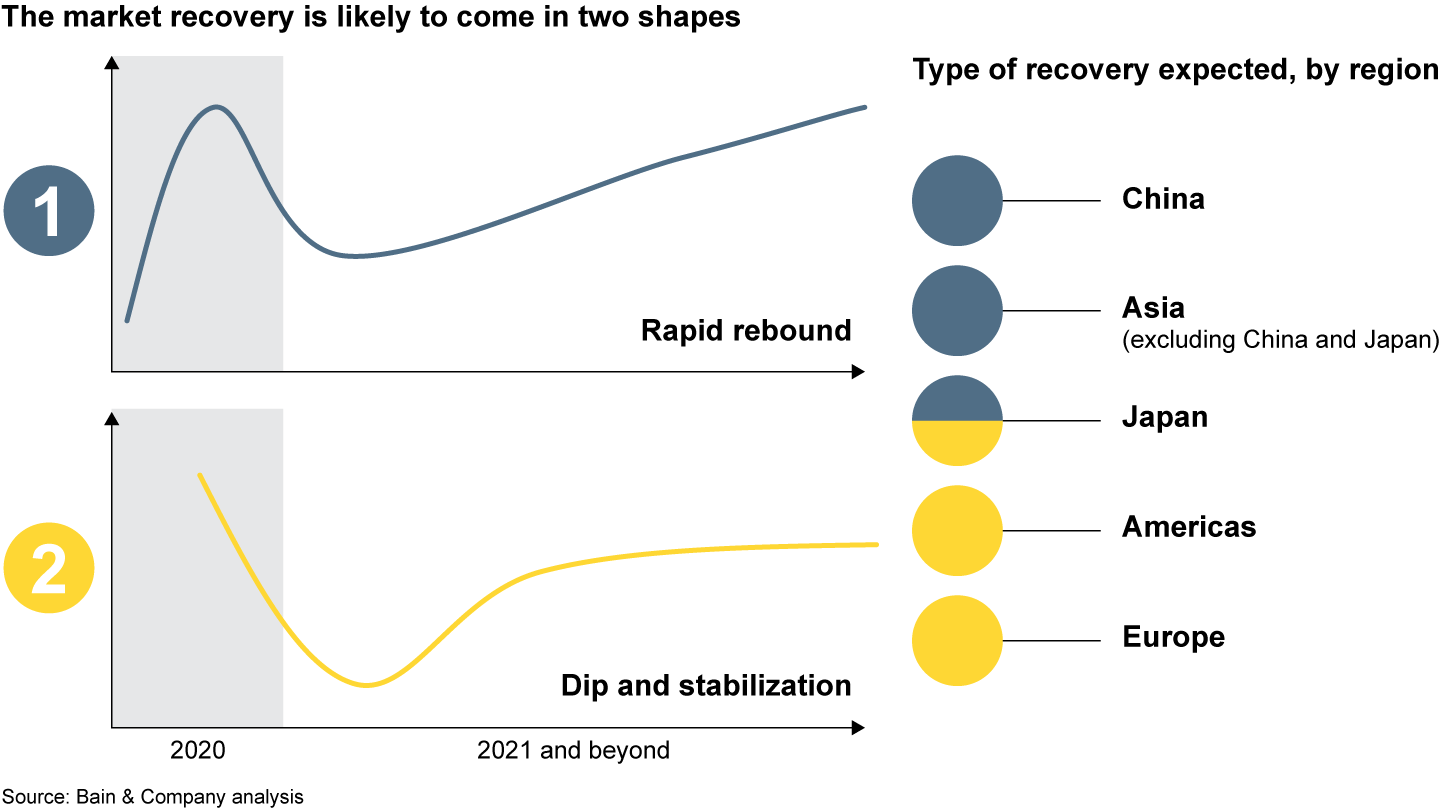
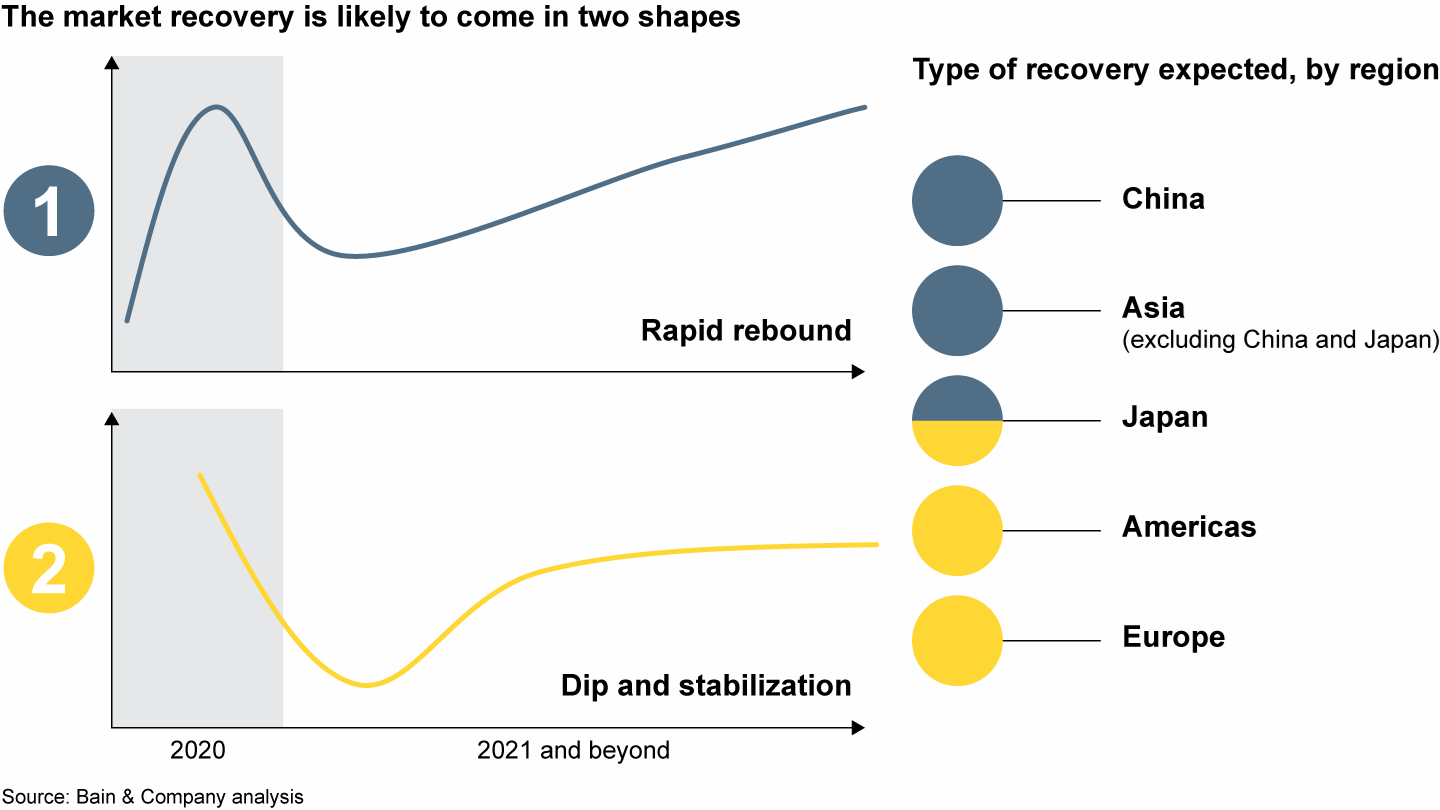
We also see six consumer trends emerging or solidifying in response to the crisis.
- More China: Luxury shopping is likely to restart first in China if the virus remains under control there. Continued restrictions on travel will mean that many purchases that would have been made abroad will happen in China.
- Accelerated shift to digital shopping: When safe, consumers will return to physical stores (possibly with a renewed passion for in-real-life experiences), but some digital shopping habits built during the outbreak will stick—especially if brands raise their game in online assortment, user experience and digital marketing.
- Heightened environmental and social consciousness: Consumer concern about sustainability and social issues is set to continue, consolidating the importance of environmental and social governance. Enlightened brands may rethink the end-to-end product life cycle, supply chain management and disposal of unsold stock.
- Rise of a post-aspirational mindset: Ethics will become as important as aesthetics as consumers prioritize purposeful brands.
- Strengthened local pride: Public opinion during the outbreak has sometimes stigmatized certain nations, triggering assertive displays of cultural pride in those territories. Brands need to avoid inflaming these local sensitivities.
- Expanding need for inclusion: Brands will need to use all their ingenuity to revamp their offer at accessible price points, reflecting the reduced spending power of many middle-class customers.
Govern through a new leadership framework
To blunt the crisis's short-term impact and respond to the trends described above, we recommend a three-pronged approach: Govern through a new leadership framework; act to maximize short-term financial, operational and brand resilience; and transform the value proposition and business model for the future.
Let's take the "govern" element first. The pandemic is above all a public health threat. Preventing infection—and supporting those who are infected—will remain the short-term priority for leadership teams in any industry, whatever the cost. That duty extends to employees (at suppliers and business partners, as well as in-house workers) and customers, regardless of whether they are in company offices, stores, event sites or traveling. Companies should emulate best practices in health and safety, even going beyond the legal minimum. They need to demonstrate empathy through their internal and external communications, as well as through actions to support the broader fight against Covid-19 (such as financial and in-kind donations).
Yet the outbreak is also an existential threat for many businesses around the world. To protect the health of both their people and their companies, leadership teams need clear, robust and regularly updated information. Contingency planning needs to be well defined and continuously reassessed; it should prioritize actions, lay out the likely timetable and triggers, and assess implications.
The following actions can help to establish a new leadership framework, which could also serve for future emergencies:
- Create dashboards and an intranet-based virtual newsroom featuring key performance indicators and information on the outbreak, worker/customer safety and business performance.
- Develop scenarios for future consumption based on the evolution of the pandemic, assessing the likely impact on the profit and loss statement, balance sheet and cash flow.
- Nominate and empower a narrow committee of crisis leaders to make rapid decisions, bringing in functional experts and external advisers where the topic demands.
- Establish a project management office to coordinate and support the committee.
- Periodically reassess the situation and adjust priorities and plans.
- Delegate to a smaller task force when that suits the objective.
- Ensure that internal and external communications are crisp and timely.
Maximize short-term financial, operational and brand resilience
The following actions can help maximize short-term financial, operational and brand resilience:
Stay relevant to customers.
- Reassure them, explaining all the measures being taken to protect people.
- Foster a sense of community amid social distancing, through engaging editorial content, virtual social gatherings and crowd-funded initiatives involving customers.
- Give one-on-one attention to top customers.
Protect the top line.
- Invest more in online sales and marketing, particularly in areas hit hardest by the pandemic.
- Update your CRM playbook to engage and sell to customers in the new circumstances; tactics could include virtual shopping sessions and direct messaging of top customers by store managers, for instance.
- For all initiatives, quickly evaluate expected upside and related costs.
- Start preparing for the recovery, setting clear go/no-go deadlines for decisions.
- Test new approaches to the next sales campaign (such as a virtual showroom or trunk shows).
Adjust operating expenditure and capital expenditure.
- Postpone fashion shows and other “nonconverting” marketing activities.
- Consider reallocating media investment from outdoor to mobile.
- Postpone all nonstrategic capex, such as store openings scheduled in affected countries.
- Manage retail costs and other costs, such as hiring, training, visual merchandising modules and props updates.
Take short-term operational contingency actions.
- Optimize working capital for the current season (for instance, by reallocating stock, opening temporary stores or rescheduling production of permanent items with sufficient stock levels).
- Put your supply chain in crisis mode, adopting measures such as a “red and blue team” approach to prototyping/manufacturing/warehousing (splitting core functions so that one team can work if someone on the other team gets sick), as well as relocating production where necessary.
- Develop a buying approach and guidelines for next season (how to allocate the open-to-buy, how to cluster stores based on expected impacts on consumption of Covid-19, what and how much to buy for identified store clusters).
- Review the open-to-buy for next season, accounting for the evolution of consumption in China and elsewhere; develop scenarios and be ready to act (for instance, by unlocking extra budget if the situation rapidly improves).
- Review the structure of next season’s collection to anticipate potential production issues and availability of key raw materials.
Transform the value proposition and business model for the future
Even before the pandemic, the luxury industry was undergoing fundamental change. Companies faced mounting pressure to become more customer-centric, digital, agile and sustainable. As they reset short-term targets and adopt new ways of working to cope with Covid-19, companies can still move toward these longer-term goals.
One way to become more customer-centric is to refresh (if not establish for the first time) a 360-degree customer strategy that coordinates the plans, value propositions and actions of all functions―with the overarching aim of greater customer intimacy.
Some companies will emerge from the crisis able to make much faster decisions, especially if they jettison inefficient legacy processes and embrace advanced analytics. The coronavirus is accelerating ad hoc adoption of video conferencing, cloud-based collaboration and telecommuting. Companies that systematically embrace these digital tools and flexible working practices will become more agile, save money, reduce their carbon footprint and attract talented young employees.
The Covid-19 response can become the catalyst for a supply chain reinvention in the luxury industry. The goal here is to preserve the elements of today’s short-term scrambling that can underpin a more reactive and flexible operation in the future—one that is increasingly decoupled from the rhythm of seasonal collections. One tactic is to prioritize suppliers and vendors that can react quickly at scale, while maintaining quality. The strongest luxury groups will keep redesigning internal processes to cut lead times and keep innovating.
Finally, the shift to online purchasing during the pandemic has highlighted the need for luxury goods manufacturers to unlock the full potential of omnichannel retailing and master digital marketing. Many leadership teams have been breaking down internal silos to streamline their response to the current disruption—and companies can’t rebuild those silos if they are to blend online and offline channels seamlessly. Companies might also want to start bringing more of their digital marketing in-house now, while moving to a nimble test-and-learn marketing model.
The global nature of luxury will be a strength again
The scale of the disruption caused by Covid-19 has little precedent—in peacetime, at least. Unlike the 2008–2009 financial crisis, there is no new pool of luxury consumers to compensate for the drop in spending by established consumers.
The worldwide scope of the outbreak is particularly bad for luxury, one of the most globalized industries on the planet. It has shut down several growth engines that had powered luxury brands to ever-increasing heights over the past two decades, most notably Chinese consumption (both in China and at tourist destinations throughout the world).
We don’t think that will be a permanent state of affairs, though. Luxury’s global reach should become a strength once more when the current situation has stabilized. Brands can even emerge from the crisis stronger. Lessons in resilience learned in the dark days of 2020 can power a sustainable recovery in 2021 and beyond. This crisis may be transforming the luxury industry for good, but it could also be a transformation for the good.

Coronavirus
The global Covid-19 pandemic has extracted a terrible human toll and spurred sweeping changes in the world economy. Across industries, executives have begun reassessing their strategies and repositioning their companies to thrive now and in the world beyond coronavirus.
Claudia D’Arpizio (claudia.darpizio@bain.com) is a Bain & Company partner and leader of the firm’s Global Luxury and Fashion vertical. Federica Levato (federica.levato@bain.com) is a Bain partner, leading member of the Luxury and Fashion vertical and coauthor of the Bain Luxury Study. Stefano Fenili (stefano.fenili@bain.com), Fabio Colacchio (fabio.colacchio@bain.com) and Filippo Prete (filippo.prete@bain.com) are senior members of the Luxury and Fashion vertical. All authors are based in the firm’s Milan office.